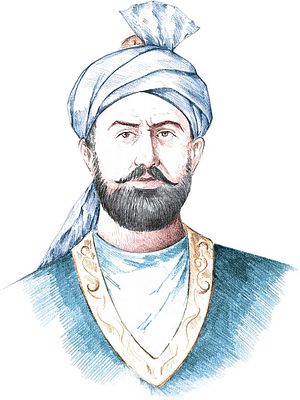Some 300 years ago, in November 1715, a powerful man passed away peacefully in Kandahar–a rarity. He had set in motion a chain of events that would profoundly change the histories of Persia and India, though he probably did not know this as he breathed his last. Mir Wais Hotak, a chief of the Pashtun Ghilji tribe, originally set out to free his city from continued Persian pressure to convert from Sunni to Shia Islam. Instead, he became the George Washington of modern Afghanistan.
At the dawn of the 18th century, much of today’s Afghanistan had been divided for 200 years. The Mughal and Safavid Empires, based in the Indian subcontinent and Persia respectively, each ruled a portion of the country. A third state, the Uzbek Khanate of Bukhara ruled the northern part of Afghanistan around Mazar-i-Sharif. Kabul was a Mughal stronghold and Herat, a Safavid one. Kandahar switched hands several times, with local Pashtun tribes generally siding with whomever they felt would be more beneficial to them. The city was a an important economic and strategic prize since it lay on the main military and trade routes between Persia and the subcontinent. By 1700, Kandahar had been in Safavid hands for half a century.
Yet, all was not well for the Safavids. The Safavid dynasty found legitimacy through their association with Shia Islam, and they succeeded in converting most of their population to Shiism from Sunni Islam over the course of 200 years. Much of Afghanistan was relatively peaceful until the reign of the Safavid Shah Soltan Husayn (ruled from 1694-1722). Shah Husayn was a drunkard and the Safavid Empire stagnated during his reign. Perhaps due to religious conviction or to strengthen his political position, he gave the Shia clergy great power to convert Sunnis, causing great unrest throughout the Empire.
The trouble in Kandahar began when the new governor, Gurgin Khan, a Georgian convert to Islam, arrived in 1704. Despite his heavy-handed methods, he could not get the region’s dominant Pashtun tribe, the Ghilji, led by Mir Wais Hotak, to fully accept his rule or convert to Shiism. Gurgin Khan arrested Hotak and sent him to Isfahan, the Persian capital, where he became friendly with the amiable Shah. While in Isfahan, Hotak noted the decadence of the Safavid Empire and became convinced that it was on the verge of collapse due to the laxness of the military and government and prevalence of court intrigue. Determined to take advantage of these circumstances, he obtained a fatwa in Mecca on the question “as to whether the orthodox Sunni subjects of a heretical [Shia] Muslim ruler were bound to obey him, or were justified, if occasion arose, in resisting him, if necessary by force of arms.” The answer being in favor of revolt, Hotak returned to Kandahar where he organized either a feast or an ambush (sources vary) that resulted in the death of Gurgin Khan and the Georgian-Persian garrison in April 1709.
What could have been a minor disturbance quickly escalated. Mir Wais Hotak was proclaimed the “Prince of Kandahar and General of the National Troops,” strangely (for his time) refusing to proclaim himself king. After several half-hearted attempts by Persian troops to regain Kandahar, a large Persian army of 30,000 men was defeated in 1711, and a second force annihilated in 1713. By the time of his natural death in 1715, Mir Wais Hotak has established an independent Afghan state that encompassed the entire province of Kandahar (most of southwestern Afghanistan). This is the seed of modern-day Afghanistan, which was reestablished as a large empire in 1747 by Ahmad Shah Durrani.
But the Hotaki Dynasty is important not only because it created a new state in Afghanistan. Mir Wais Hotak’s son, Mahmud Hotak, proclaimed himself king, and in 1720 moved west into Iran with an army of rebels. Nobody in Isfahan seemed to have seen this invasion as a major threat and treated the situation as an incident of banditry. Thus to everyone’s surprise and beyond Shah Mahmud Hotak’s wildest dreams, Afghan forces defeated Persian troops outside of Isfahan in 1722. Shah Husayn then surrendered the crown to Mahmud Hotak.
Thus began decades of depredation and chaos in the region, for Mahmud Hotak could not hold all of the former Safavid Empire, which suffered several revolts, and invasions by the Ottoman Turks and Russians. He himself was murdered by a cousin and anarchy prevailed throughout Iran and Afghanistan. Eventually, some order was restored when former Safavid loyalists joined forces with a soldier of fortune, Nader Shah, who eventually become the new ruler of Iran and Afghanistan, defeating Turkish and Afghan forces. He was aided by a rival tribe of Pashtun Afghans, the Abdalis near Herat, who had previously been defeated by the Ghilji tribe. Due to alleged Mughal support for the Afghans, Nader Shah attacked Kabul after capturing Kandahar, and by 1739, his forces had sacked Delhi, the Mughal capital, though he retained the Mughal empire after significant territorial and financial concessions.The Mughal Empire, however, was fatally weakened from this point on, and its effective control soon barely reached beyond Delhi. After Nader Shah was assassinated in 1747, Iran returned to anarchy for another 50 years and erstwhile his Abdali Afghan general, Ahmad Shah Durrani absconded with his treasury to Kandahar, where he founded a new Afghan Empire that continued to ravage Persia and India for a while before eventually being beaten back by Iran’s Qajar Dynasty and the Sikh Empire and, though there were mere shadows of the strength of the erstwhile powers of Persia and India.
One small revolt in 1709 laid the foundations of an independent Afghan state and a century of chaos in India and Iran. This came at a crucial time, when colonial powers were beginning to expand into those regions. Perhaps history would have been different if Europeans encountered stronger, functioning empires in Persia and the subcontinent instead of regions thrown into anarchy by troubles on their frontiers.

































